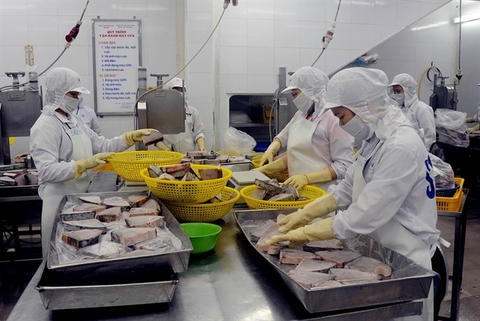
Workers process seafood products for export at Binh Dinh Fishery Joint Stock Company in the central province of Binh Dinh. The company majors in exporting seafood to European countries, the US and Canada. — VNA/VNS Photo Quang Quyet
Canada had become a promising market for Vietnamese goods following the signing of the Comprehensive and Progressive Agreement for Trans-Pacific Partnership (CPTPP), heard a workshop in Ha Noi on Thursday.
The CPTPP, which took effect in Viet Nam on January 14, includes Australia, Brunei, Canada, Chile, Japan, Malaysia, Mexico, New Zealand, Peru, Singapore and Viet Nam that altogether make up 13.5 per cent of global GDP.
Ta Hoang Linh, director of the European-American Market Department under the Ministry of Industry and Trade (MoIT), said Canada was one of the CPTPP members that had the highest market-opening commitments. Under the pact, it would cut tariffs on 95 per cent of imports to zero, and that covered 78 per cent of Viet Nam’s total export revenue to Canada.
Canada was also one of the three CPTPP members with which Viet Nam had not yet signed a bilateral trade agreement. Meanwhile, the two sides’ export structures did not compete and complemented each other.
If businesses could take this opportunity, the CPTPP would open the door for processed and manufactured products textiles and garments, footwear, wood and aquatic products, Linh said.
Jared Brading, counsellor for Development Cooperation at the Canadian Embassy in Viet Nam, said the CPTPP implementation would bring about more trade and investment chances, helping to strengthen the trade partnership, especially in terms of agricultural and food.
For Canada, this agreement would help reinforce relations with new free trade agreement partners like Viet Nam and improve Vietnamese consumer awareness of Canadian goods, he said, noting his hope that Vietnamese goods would increase their presence in his country.
Brading added the CPTPP would also facilitate Canadian companies’ investment in and provision of technical support for Viet Nam within the official development assistance framework to help local firms, especially those run by women, to benefit from trade liberalisation.
At the workshop, Nguyen Son Tra, an official from the MoIT’s Multilateral Trade Policy Department, said the enforcement of the CPTPP was considered a driving force for bilateral trade.
With the immediate elimination of 95 per cent of import tariff lines after the deal took effect, which covers 78 per cent of Viet Nam’s exports to this market, Canada generated numerous export chances for Viet Nam.
She said all of Viet Nam’s aquatic exports to Canada had benefited from a zero-per cent tariff since January 14. The North American market had also reduced import tariffs on wooden furniture, tea, pepper and cashew nuts to zero per cent. It would remove all tariffs on textile-garment imports in the fourth year after the CPTPP came into force.
Meanwhile, 78 per cent of Viet Nam’s exports of footwear – another major foreign currency earner – to Canada have also enjoyed a zero-percent tariff immediately after the trade pact took effect.
Statistics show that in 2018, Viet Nam shipped more than US$3.01 billion worth of goods to Canada. Bilateral trade reached $379 million in January this year, including $317 million of Viet Nam’s exports. — VNS